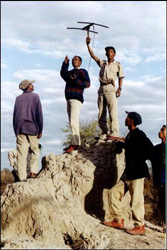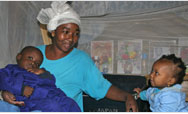
Photo: WWF/Chris Weaver
Nyae Nyae Conservancy rangers with an antenna to monitor the movement of introduced eland and oryx.
“By linking conservation and rural development, communal area residents are deriving direct income from the sustainable use of natural resources.”
– Minister of Environment and Tourism, Philemon Malima.
|
Results
Today, the Nyae Nyae Conservancy has a campsite and one of Namibia’s most lucrative trophy hunting contracts. Its members are also benefiting from handicraft sales and game meat distributions. In 2003, conservancy activities provided 35% of total cash income to residents and 28% of the area’s employment.
With the financial incentive to protect game, coupled with a USAID-supported program to boost the numbers of certain species in the conservancy through game transfers from other conservancies and elsewhere, wildlife numbers have increased significantly. From 1998 to 2003, springbok has been reintroduced into the area, with numbers rising from 0 to 880; oryx numbers have risen from 430 to 1170; and kudu numbers have risen from 280 to 950. The Nyae Nyae Conservancy also has Namibia’s largest population of roan
antelope and valuable herd of buffalo.
Print-friendly version of this page (248kb - PDF)
|


